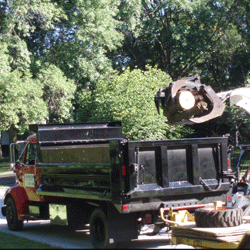(708) 755-7918
Service Area
A+ Rated by BBB
The reward for work done well is the opportunity to do more!
Fully insured, licensed and bonded, including workman’s compensation. |

|
ask about senior citizen discounts! |
|
Tree Trimming Services
STOP, LISTEN. Your Trees Can Speak...
It has been said that the pruning of trees and treatment of wounds are probably the most important of all tree maintenance practices. When promptly completed, correct pruning can do much to reduce the effects of storm damage and prevent insect and disease problems in shade trees. Aside from being more pleasing in appearance, properly pruned shade trees will normally remain healthier and live longer than uncared for and unpruned trees. Insect problems and wood decay often enter a tree through a dead branch or wounds resulting from injury. Prompt treatment of such conditions, such as pruning where necessary, will usually prevent the effects of the injury from causing further damage to the tree.
When done properly, pruning will usually serve to invigorate (stimulate) a tree as it allows more of the food material that the tree produces to be used by the remaining parts of the tree. Since each healthy leaf on the tree can manufacture food, one should always keep in mind the relationship between total leaf area remaining on the tree after pruning and future growth of the tree.
Reasons for Pruning
Trees and other woody plants are pruned for a variety of reasons. The purpose for which the tree is being grown will greatly influence the time, amount, and type of pruning that is given. As an example, pruning for forestry purposes differs considerably from pruning by utility crews to maintain line clearance on power line rights-of-way. Let us look briefly at some of the main reasons for pruning in general, with a more detailed discussion of the reasons that shade and ornamental trees are pruned.
Horticulture
Horticulturists and orchardists regularly prune fruit trees and vineyards for a variety of reasons. This is done primarily to increase fruit production, although pruning early in the life of the plant is designed to train and improve the structure of the plant in order to support future fruit yields, or make collection and harvesting of fruit easier. It is now common practice among orchardists to train and prune fruit trees so that mechanized harvesting can be used.
Shade, and Ornamental Trees
The reasons for pruning shade and ornamental trees differs considerably from horticultural and/or forestry purposes. We are most commonly concerned with improving or maintaining the tree in an attractive vigorous condition or to repair damage due to accidents.
It would be well at this point to consider an additional aspect of pruning. Pruning may be divided into two general classifications: training and maintenance pruning. Training indicates the type of pruning that is done while the tree is young to develop a desired form or shape.
Maintenance Pruning
Maintenance pruning is that which is done to keep the tree in a vigorous, productive and healthy condition. Some specific reasons for pruning trees include the following:
Appearance: Shaping a tree to bring it into its natural form or prevent the development of poorly shaped branches are examples of pruning for appearance. In formal garden and landscape settings, the shape of specimen trees is most important and pruning may be necessary on a regular basis to maintain desired shapes.
Health: Pruning trees for maintenance and health falls into several categories. The removal of damaged, diseased or insect infested parts of the tree to prevent the entrance of wood decaying organisms. Other examples might include the removal of live branches to create conditions favorable for air movement and the entrance of sunlight into the inner portion of the crown. Rubbing, overlapping and other branches growing toward the center of the tree are often removed to prevent damage and possible decay. Dead branch stubs should always be removed to the branch collar to promote rapid closure and prevent further decay. Older trees may occasionally be pruned more severely in an effort to revitalize them.
Preventing Storm Damage: A special type of pruning for health is to anticipate problems which may develop. One of the more important reasons for pruning is to prevent storm damage. The Chicagoland area has regular problems with storms. Proper pruning helps avoid much of the damage to trees caused by storms. If one stands away from the trunk at a distance equal to the height of the tree, he can readily judge the density of foliage and what percentage of sky shows through. Ten to 25% of sky should be seen in the small and young trees; and 25-40% or even more, in certain cases, might be used as a guide for the large and full grown trees. Care should be taken not to over thin. The basic reason for this pruning is to open the tree so winds can blow through without serious difficulty. When trees are too dense, there is too much wind resistance. This causes branches to be twisted and torn by the wind. The removal of improperly spaced branches can be a great help in preventing storm damage.

Safety: Pruning for safety is often considered to be the most important of all street tree maintenance practices. Dead and broken limbs present a constant danger to buildings, wires, and other properties, in addition to their danger to pedestrians and passerby. Low hanging branches must often be removed to maintain open areas at many street intersections. The removal of branches with included bark is another example of pruning for safety. This type of pruning anticipates possible future damage and removes the cause before actual damage happens. The reasons for pruning mentioned above will cover most of the situations. Other less common reasons for pruning might include pruning to open up a vista (a view beyond the trees) and pruning to develop screens or barriers.




